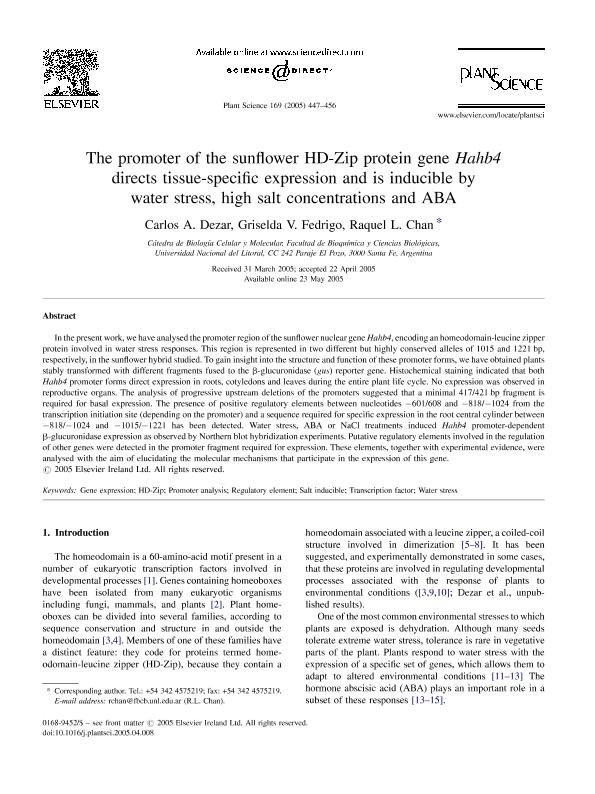Mostrar el registro sencillo del ítem
dc.contributor.author
Dezar, Carlos Alberto Alejandro

dc.contributor.author
Fedrigo, Griselda Valeria

dc.contributor.author
Chan, Raquel Lia

dc.date.available
2020-04-15T19:10:13Z
dc.date.issued
2005-08
dc.identifier.citation
Dezar, Carlos Alberto Alejandro; Fedrigo, Griselda Valeria; Chan, Raquel Lia; The promoter of the sunflower HD-Zip protein gene Hahb4 directs tissue-specific expression and is inducible by water stress, high salt concentrations and ABA; Elsevier Ireland; Plant Science; 169; 2; 8-2005; 447-456
dc.identifier.issn
0168-9452
dc.identifier.uri
http://hdl.handle.net/11336/102672
dc.description.abstract
In the present work, we have analysed the promoter region of the sunflower nuclear gene Hahb4, encoding an homeodomain-leucine zipper protein involved in water stress responses. This region is represented in two different but highly conserved alleles of 1015 and 1221 bp, respectively, in the sunflower hybrid studied. To gain insight into the structure and function of these promoter forms, we have obtained plants stably transformed with different fragments fused to the b-glucuronidase (gus) reporter gene. Histochemical staining indicated that both protein involved in water stress responses. This region is represented in two different but highly conserved alleles of 1015 and 1221 bp, respectively, in the sunflower hybrid studied. To gain insight into the structure and function of these promoter forms, we have obtained plants stably transformed with different fragments fused to the b-glucuronidase (gus) reporter gene. Histochemical staining indicated that both Hahb4, encoding an homeodomain-leucine zipper protein involved in water stress responses. This region is represented in two different but highly conserved alleles of 1015 and 1221 bp, respectively, in the sunflower hybrid studied. To gain insight into the structure and function of these promoter forms, we have obtained plants stably transformed with different fragments fused to the b-glucuronidase (gus) reporter gene. Histochemical staining indicated that bothb-glucuronidase (gus) reporter gene. Histochemical staining indicated that both Hahb4 promoter forms direct expression in roots, cotyledons and leaves during the entire plant life cycle. No expression was observed in reproductive organs. The analysis of progressive upstream deletions of the promoters suggested that a minimal 417/421 bp fragment is required for basal expression. The presence of positive regulatory elements between nucleotides -601/608 and -818/-1024 from the transcription initiation site (depending on the promoter) and a sequence required for specific expression in the root central cylinder between transcription initiation site (depending on the promoter) and a sequence required for specific expression in the root central cylinder between reproductive organs. The analysis of progressive upstream deletions of the promoters suggested that a minimal 417/421 bp fragment is required for basal expression. The presence of positive regulatory elements between nucleotides -601/608 and -818/-1024 from the transcription initiation site (depending on the promoter) and a sequence required for specific expression in the root central cylinder between transcription initiation site (depending on the promoter) and a sequence required for specific expression in the root central cylinder between promoter forms direct expression in roots, cotyledons and leaves during the entire plant life cycle. No expression was observed in reproductive organs. The analysis of progressive upstream deletions of the promoters suggested that a minimal 417/421 bp fragment is required for basal expression. The presence of positive regulatory elements between nucleotides -601/608 and -818/-1024 from the transcription initiation site (depending on the promoter) and a sequence required for specific expression in the root central cylinder between transcription initiation site (depending on the promoter) and a sequence required for specific expression in the root central cylinder between 601/608 and -818/-1024 from the transcription initiation site (depending on the promoter) and a sequence required for specific expression in the root central cylinder between -818/-1024 and -1015/-1221 has been detected. Water stress, ABA or NaCl treatments induced Hahb4 promoter-dependent-818/-1024 and -1015/-1221 has been detected. Water stress, ABA or NaCl treatments induced Hahb4 promoter-dependent b-glucuronidase expression as observed by Northern blot hybridization experiments. Putative regulatory elements involved in the regulation of other genes were detected in the promoter fragment required for expression. These elements, together with experimental evidence, were analysed with the aim of elucidating the molecular mechanisms that participate in the expression of this gene. of other genes were detected in the promoter fragment required for expression. These elements, together with experimental evidence, were analysed with the aim of elucidating the molecular mechanisms that participate in the expression of this gene. -glucuronidase expression as observed by Northern blot hybridization experiments. Putative regulatory elements involved in the regulation of other genes were detected in the promoter fragment required for expression. These elements, together with experimental evidence, were analysed with the aim of elucidating the molecular mechanisms that participate in the expression of this gene.
dc.format
application/pdf
dc.language.iso
eng
dc.publisher
Elsevier Ireland

dc.rights
info:eu-repo/semantics/openAccess
dc.rights.uri
https://creativecommons.org/licenses/by-nc-sa/2.5/ar/
dc.subject
HaHB4
dc.subject
Promoter
dc.subject
ABA
dc.subject
Estrés hídrico
dc.subject.classification
Bioquímica y Biología Molecular

dc.subject.classification
Ciencias Biológicas

dc.subject.classification
CIENCIAS NATURALES Y EXACTAS

dc.title
The promoter of the sunflower HD-Zip protein gene Hahb4 directs tissue-specific expression and is inducible by water stress, high salt concentrations and ABA
dc.type
info:eu-repo/semantics/article
dc.type
info:ar-repo/semantics/artículo
dc.type
info:eu-repo/semantics/publishedVersion
dc.date.updated
2020-04-13T13:15:05Z
dc.journal.volume
169
dc.journal.number
2
dc.journal.pagination
447-456
dc.journal.pais
Irlanda

dc.journal.ciudad
Shannon
dc.description.fil
Fil: Dezar, Carlos Alberto Alejandro. Universidad Nacional del Litoral. Facultad de Bioquímica y Ciencias Biológicas. Departamento de Ciencias Biológicas. Cátedra de Biología Celular y Molecular; Argentina. Consejo Nacional de Investigaciones Científicas y Técnicas. Centro Científico Tecnológico Conicet - Santa Fe; Argentina
dc.description.fil
Fil: Fedrigo, Griselda Valeria. Consejo Nacional de Investigaciones Científicas y Técnicas. Centro Científico Tecnológico Conicet - Santa Fe; Argentina. Universidad Nacional del Litoral. Facultad de Bioquímica y Ciencias Biológicas. Departamento de Ciencias Biológicas. Cátedra de Biología Celular y Molecular; Argentina
dc.description.fil
Fil: Chan, Raquel Lia. Consejo Nacional de Investigaciones Científicas y Técnicas. Centro Científico Tecnológico Conicet - Santa Fe; Argentina. Universidad Nacional del Litoral. Facultad de Bioquímica y Ciencias Biológicas. Departamento de Ciencias Biológicas. Cátedra de Biología Celular y Molecular; Argentina
dc.journal.title
Plant Science

dc.relation.alternativeid
info:eu-repo/semantics/altIdentifier/doi/https://doi.org/10.1016/j.plantsci.2005.04.008
dc.relation.alternativeid
info:eu-repo/semantics/altIdentifier/url/https://www.sciencedirect.com/science/article/pii/S0168945205001469
Archivos asociados
